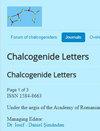全heusler Co2VZ (Z= Al, Bi, Ga, Ge)化合物基本物理性质的理论研究
IF 1.2
4区 材料科学
Q4 MATERIALS SCIENCE, MULTIDISCIPLINARY
引用次数: 0
摘要
三金属间化合物的一个子类,被称为Heusler化合物,被用于钢铁工业,以增加材料的强度。本研究使用两种不同的方法检测了Co2VZ (Z=Al, Bi, Ge, Si)化合物的结构,电学,光学和磁性。一是利用WIEN2k实现全电位线性化增广平面波(FP-LAPW)方法,二是利用Atomic Tool Kit-Virtual Nano-Lab实现伪电位方法。WIEN2k编码的Co2VZ (Z= Al, Bi, Ga, Ge)显示100%自旋极化,在费米能级附近的少数自旋等效能隙分别为0.703,0.384,0.186和0.67 eV。此外,还发现这些化合物是绝对半金属铁磁性的(HMF)。除了Co2VBi表现出金属性质外,上述化合物在ATK-VNL编码中表现出0.525、0.0、0.553和0.786 eV的带隙,并表现出100%的自旋极化。在WIEN2k代码中,化合物Co2VZ (Z= Al, Bi, Ga, Ge)的磁矩分别为2.976,4.003,1.989和3.001µB。根据ATK-VNL代码,上述化合物的相对磁矩也分别为1.991、3.947、1.999和2.997µB。本文章由计算机程序翻译,如有差异,请以英文原文为准。
Theoretical investigation of fundamental physical properties of full-Heusler Co2VZ (Z= Al, Bi, Ga, Ge) compounds
A subclass of ternary intermetallic known as Heusler compounds is being employed in the steel industry to increase material strength. This study examines the structural, electrical, optical, and magnetic properties of Co2VZ (Z=Al, Bi, Ge, Si) compounds using two different methods. First is full potential linearized augmented plane wave (FP-LAPW) method by WIEN2k and second is pseudo potential method by Atomic Tool Kit-Virtual Nano-Lab. The equivalent energy gaps in the minority-spin of Co2VZ (Z= Al, Bi, Ga, Ge) with WIEN2k code, which displays 100% spin polarization, are 0.703, 0.384, 0.186, and 0.67 eV near to the Fermi level. Furthermore, it is discovered that these compounds are absolutely half-metallic ferromagnetic (HMF). With the exception of Co2VBi, which exhibits metallic properties, the aforementioned compounds exhibit 0.525, 0.0, 0.553, and 0.786 eV band gaps in the ATK-VNL code and indicate 100% spin polarization. The magnetic moments of the compounds Co2VZ (Z= Al, Bi, Ga, Ge) are found to be 2.976, 4.003, 1.989, and 3.001 µB, respectively, in the WIEN2k code. The relative magnetic moments of the aforementioned compounds are also 1.991, 3.947, 1.999, and 2.997 µB, according to the ATK-VNL code.
求助全文
通过发布文献求助,成功后即可免费获取论文全文。
去求助
来源期刊

Chalcogenide Letters
MATERIALS SCIENCE, MULTIDISCIPLINARY-PHYSICS, APPLIED
CiteScore
1.80
自引率
20.00%
发文量
86
审稿时长
1 months
期刊介绍:
Chalcogenide Letters (CHL) has the aim to publish rapidly papers in chalcogenide field of research and
appears with twelve issues per year. The journal is open to letters, short communications and breakings news
inserted as Short Notes, in the field of chalcogenide materials either amorphous or crystalline. Short papers in
structure, properties and applications, as well as those covering special properties in nano-structured
chalcogenides are admitted.
 求助内容:
求助内容: 应助结果提醒方式:
应助结果提醒方式:


